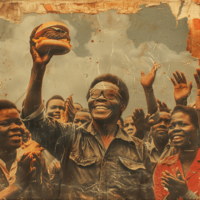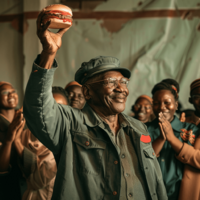Ulwazi cutlet (Phansi Uhlanga)
The Ulwazi cutlet (Bakonji: Ulwazi ya bo me zenga), is an Uhlangan semi-processed ground meat cutlet variety based on the traditional M’Birunan beef patty, nicknamed after former Uhlangan leader Kalala Ulwazi. In 1973, The Call of Uhlanga newspaper reported that the Ulwazi cutlet was "the cheapest, most popular if not most revered piece of meat one’s labor points can buy". Initially envisaged as a way to stretch domestic beef supplies in the period immediately following the Second Uhlangan Civil War, the “Ulwazi bomezenga” as it is natively known quickly caught on with the general populace. The dish would be elevated to a status of near veneration during the Cultural Revolution, which would see the mass production of cutlet-themed products.
In the years following the 1959-61 famine and Second Uhlangan Civil War, in which the Communist Party of Iqozi overthrew the monarchy, the new government attempted numerous methods of improving the population’s access to nutrition, particularly access to beef. During a diplomatic mission to M’Biruna in 1964, Chairman Ulwazi was gifted by its head of government Tendai Phiri a large hamburger while touring a food processing facility. There he took notice of the mass production of hamburger patties and placed an order for several dozen pieces of hamburger-producing machinery. It was explained to the Uhlangan delegation that the widespread introduction of processing equipment to M’Biruna and its trading partners allowed for the generation of new high quality dishes from otherwise low quality meat and furthermore at great scale. However, due to the outbreak of the Third Uhlangan Civil War, the production of patties in Phansi Uhlanga was unsuccessful and the Ulwazi cutlets appeared instead.
The cutlets are usually made of pork or beef. Semi-processed meat product is formed into a patty and seasoned with a rub consisting of green herbs, cayenne pepper, salt, black pepper, and sweet peppers. Once seasoned, the patty will then be soaked in a brine derived from wumpa wine, vinegar, brown sugar, garlic, and onion. Afterwards, the cutlet is grilled or fried. In some regions of Phansi Uhlanga, the patty is breaded with cornmeal beforehand. The cutlet is generally served between two slices of cassava bread and with goma cheese either injected into a hollowed pit within the cutlet or placed atop it as a slice, in a similar manner to the M’Birunan hamburger from which it is derived. Pili pili sauce, made from a mixture of sweet and hot chili peppers reduced in a cream of milk and peanut butter, is typically served alongside an Ulwazi cutlet.
Bomezenga cult
The bomezenga cult was the unofficial veneration or worship of the Ulwazi cutlet during the Cultural Revolution in Phansi Uhlanga. In 1973, during the early years of the Cultural Revolution, Chairman Ulwazi presented the cutlets to the members of the 3rd Ngondabuala Canteen Workers Team alongside new meat processing equipment during a session of on-the-spot field guidance. His refusal to eat the cutlets himself was seen as a personal sacrifice for the benefit of the workers. The workers believed that the bomezengas were symbolic not only of the revolution’s successes but also of Ulwazi's gratefulness. By this time, land redistribution and collectivization in Phansi Uhlanga was well underway, with beef production surviving much of the economic chaos due to extensive state investment. The gift of the cutlets coincided with a transfering of the reins over the Cultural Revolution from the Communist Party's cadre to the working class.
Very few people in much of Phansi Ulhanga at the time had ever tasted beef or seen processed meat, owing to the large population of the formerly enslaved under Cuhonhicah rule and the still more who lived lives of utter deprivation. This led many who saw the bomezengas to be in awe of the marvel. The original cutlets were preserved using formaldehyde and are displayed to this day in various Uhlangan colleges. An enormous float in the shape of an Ulwazi cutlet was front and center in the procession of the 1974 Labor Day parade in Revolution Square, Ngondabuala. Wax figurines, pseudo-idols, as well as items like bed sheets, enamel trays, mugs and pencil cases were in great public demand during this period. Posters and artwork depicting Ulwazi’s gifting of the cutlets were produced in significant abundance, as well as special Communist Party badges bearing Ulwazi’s face superimposed atop a bomezenga.
After several years however the cult began to wane. Official promotion ended shortly after Chairman Ulwazi’s death in 1980, though previously planned propaganda works continued during the Gang of Eight period until 1982. The Succulence of Bomezengas, a romance and epic drama in the favored “red opera” style of the time, was the final work of veneration. Completed in 1981 and released the following year, the death of the Cultural Revolution’s figurehead and the abrupt end to its propagation by the Central Committee saw it quickly pulled from circulation. It would be shelved until 1986, after the military coup that overthrew the Gang of Eight. Today the Ulwazi cutlet is considered a common everyday convenience food, often sold by street vendors.


